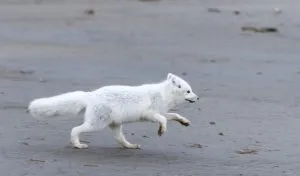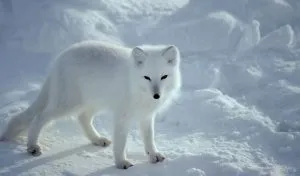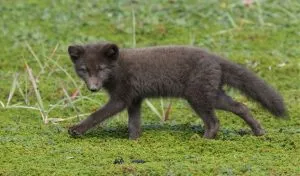Arctic foxes (Vulpes lagopus) have captured the hearts of many visitors to the arctic with their beautiful white coats and playful nature. But these snow-dwelling foxes have many other qualities that make them super interesting to study.
In this article, we’re going to share 17 amazing facts about arctic foxes, including some that are little-known to most people. As always, all of our facts are backed by science and research.
- 1. They come from the same family as dogs
- 2. They change color in winter
- 3. Their dens can have up to 150 entrances and exits
- 4. There are between 330,000 – 930,000 arctic foxes left in the wild
- 5. They traveled to Iceland on sea ice but then got stuck there when the ice melted
- 6. They are not fussy eaters
- 7. They follow polar bears around and eat their leftovers
- 8. There’s a rare blue arctic fox
- 9. Arctic foxes can swim for 2km
- 10. They have the largest known litter size in the order of Carnivora
- 11. They bury excess food and save it for winter
- 12. Some scientists believe they originated in Asia
- 13. They only experience one year of abundant food in their lives
- 14. They have excellent hearing
- 15. They can hunt in the day or at night
- 16. In some regions, they are endangered
- 17. Arctic foxes aren’t dangerous to humans
1. They come from the same family as dogs
Arctic foxes are members of the Canidae family of animals. They fall into the sub-group of canines which includes other foxes, wolves, coyotes, and domesticated dogs.
The size of an arctic fox from its head to the tip of its tail is 849mm for an average male and 810mm for females, which makes them one of the smallest canines.
2. They change color in winter
It’s a well-known fact that arctic foxes have thick white fur that helps them blend in with the snowy arctic landscape, but did you know that they aren’t white year-round? In summer, they shed their winter coat for a thinner brown/grey summer coat.
These earthy tones help them maintain camouflage during the summer months as the snow melts in many areas. They molt their winter coat in May and begin to grow it again around September1 (source: PubMed, DI Våge, et al, 2005).
This is not uncommon, seasonal molting can be observed in 21 different species from 5 families of birds and mammals. Find out more about why arctic foxes change color in our dedicated article.
3. Their dens can have up to 150 entrances and exits
Arctic foxes are territorial and have dens that are usually shared by just one family. They can remain in these dens for up to 5 years at a time but the dens are reused and can last hundreds of years.
The main purpose of the den is for shelter and to evade predators. They are large maze-like systems beneath the surface which can have up to 150 entrances and exits to quickly escape when needed2 (source: Canids: Foxes, Wolves, Jackals and Dogs, C. Sillero-Zubiri, M. Hoffmann, and D.W. Macdonald, 2004).
4. There are between 330,000 – 930,000 arctic foxes left in the wild
Arctic foxes are found across the arctic region, inhabiting Alaska, Canada, Greenland, Iceland, Russia, and Fennoscandia.
There are estimated to be about 630,000 arctic foxes left in the world. However, there are several areas where the population numbers have not been studied closely, so the figure could be as low as 330,000 or as high as 930,0003 (source: IUCN Canid Specialist Group, C. Sillero-Zubiri, M. Hoffmann, and D. W. Macdonald, 2004).
See our full guide on how many arctic foxes are left to find out more about their population and how they are distributed across the arctic.
5. They traveled to Iceland on sea ice but then got stuck there when the ice melted
Arctic foxes first colonized Iceland around 200-500 years ago during a ‘mini ice age’. The presence of sea ice allowed them to travel from Russia, Alaska, and Canada to Iceland.
However, as the temperatures warmed again, the sea ice melted and the arctic foxes became stuck on the island. Being isolated from other populations, the Icelandic arctic fox has diverged genetically from its mainland counterparts4 (source: Durham University).
6. They are not fussy eaters
Arctic foxes are omnivores because they eat both plants and animals. There are two distinct diets between inland and coastal arctic foxes.
Those found inland mainly eat small rodents such as lemmings, whereas those in coastal favor seabirds, fish, ringed seal pups, and marine invertebrates5 (source: The Biology and Conservation of Wild Candids, D. W. Macdonald, and C. Sillero-Zubiri, 2004).
When their regular food is in short supply, they’ll scavenge anything they can get their paws on, including eggs, berries, seaweed, and larger animal carcasses6 (source: Journal of Zoology, B. Elmhagen, et al, Vol 251, Issue 2, 2000). This has lead many to describe them as opportunistic omnivores.
7. They follow polar bears around and eat their leftovers
We mentioned that they eat carcasses of larger animals, however, these are not animals they have hunted themselves. One of their common hunting tactics during winter is to follow polar bears around the sea ice.
The polar bears use the sea ice to hunt seals and other marine mammals, often leaving large parts of the carcass behind afterward which the arctic fox can scavenge.
They make a great hunting pair as the polar bear prefers the fatty blubber to help maintain their enormous body mass, this leaves the meaty parts for the arctic fox. Caution must be taken as the polar bear may hunt the arctic fox if food is scarce, although this is quite rare.
8. There’s a rare blue arctic fox
Although the majority of arctic foxes are the white ones that we are most familiar with, around 1% of the population are the rarer blue morph arctic fox7 (source: ICUN, C.Sillero-Zubiri, M. Hoffmann and D.W. Macdonald, 2004).
The blue morph is mainly founded inhabiting coastal areas of Greenland, Iceland, and Fennoscandia where their blue/grey coat blends in with the rocky cliffs.
They also change color to some extent. In summer, they have a dark gray/blue coat which they shed for a slightly lighter gray coat in winter.
9. Arctic foxes can swim for 2km
Like other foxes, arctic foxes can swim. Whilst they try to avoid swimming where possible, they will get in the water to evade predators and when moving between sea ice and the mainland.
They have been known to swim up to 2km when moving between sea ice and across lakes or rivers8 (source: Journal of Animal Ecology, J.D. Roth, Vol 72, 2003). They are steady swimmers with a dense coat that provides some buoyancy, although they are not fast.
When catching prey such as fish and other marine invertebrates, arctic foxes tend to use rock pools, keeping all four paws on land and thrusting their head into the water.
10. They have the largest known litter size in the order of Carnivora
The reproduction cycle of an arctic fox consists of mating (February – March), birth (April – July), and rearing young (June – September).
They have the largest known litter size in the order of Carnivora which has been reported as high as 19 cubs on Wrangel Island, Russia in high lemming years9 (source: Canids, C. Sillero-Zubiri, M. Hoffmann and D.W. Macdonald, 2004). However, it can vary between regions and between years depending upon the abundance of food resources. Other regions such as Iceland and Canada have average litter sizes of 4.2 and 6.3 respectively.
There is more variation in litter size among inland arctic foxes due to variance in the lemming population (see fact no. 13 for more on this).
Larger litters result in smaller cubs. In Iceland, where litters are relatively small, cubs weigh 80-85g at birth.
11. They bury excess food and save it for winter
Kids will love this next arctic fox fact, especially if they have a dog at home that buries food too.
Arctic foxes can manage variations in food supply throughout the year by storing excess food in summer and fall ahead of the winter. This behavior is known as hoarding or caching.
They will often dig holes in the ground for excess food, put it under a stone, or drag it into their den. Some caches have been reported to contain more than 100 seabirds10 (source: Arctic, P. Prestrud, Vol 44, No. 2, 1991).
12. Some scientists believe they originated in Asia
It is widely thought that arctic foxes evolved in Europe during the ice age that occurred 2.6 million years ago. However, one group of scientists discovered fossils in the Tibetan mountains of south and central Asia11 (source: Nature, J. Qui, 2014).
The fossils were 3.6 million to 5.1 million years old and were more similar to arctic foxes than any other fox breed. The study suggests that arctic foxes might have adapted to the cold in the alpine tundra of the Tibetan Plateau before expanding to the arctic tundra during the ice age.
It’s worth mentioning that this theory is not backed by all scientists, with some suggesting that the similarities do not mean that one gave rise to the other.
13. They only experience one year of abundant food in their lives
Arctic foxes that live inland and rely on a diet of small rodents such as lemmings will experience peak years followed by many years of scarcity12 (source: Journal of Zoology, A. Angerbjörn, Vol 251, 2000).
Lemming populations peak every 3-5 years, whilst the average lifespan of an arctic fox is 3 years. This means that most inland arctic foxes will only experience one year of abundant food during their lives.
14. They have excellent hearing
Arctic foxes have very sensitive hearing and a keen sense of smell. When hunting for prey such as lemmings, they can hear the high-pitched rustling that they make as they scuffle beneath the surface of the snow.
They will stay very still, making use of their camouflage to remain hidden. Once they have pinpointed the exact position of the prey using their hearing, they will pounce by jumping in the air and diving head-first into the snow, almost always emerging with some food in their mouth13 (source: How do arctic foxes hunt in the snow?, Colarado State University, Feb 2021).
15. They can hunt in the day or at night
Although arctic foxes are mainly nocturnal, unlike kit foxes and red foxes which have vision better suited to nighttime activity, arctic foxes are well adapted for both day and night vision14 (source: The American Naturalist, J.L. Kavanau, and J. Ramos, Vol 109, No. 968, 1975).
This is essential in the arctic which can experience more than 24 hours of darkness during winter (known as polar nights) and more than 24 hours of sunlight during summer (known as midnight sun).
16. In some regions, they are endangered
According to the World Wildlife Fund (WWF), there are several hundred thousand arctic foxes left in the world15 (source: WWF).
As a species, arctic foxes are classified as ‘least concern’ by the ICUN since they are abundant in some regions such as Canada and Alaska. However, they are critically endangered in Norway, endangered in Sweden, and are extinct in Finland16 (source: Polar Research, A. Landa, Vol 36, Issue 9, 2017).
There are several reasons why the arctic fox is endangered and most are closely related to climate change. The main causes are changes in abundance of their main prey (see fact no.13 earlier), habitat loss as the treeline that defines the arctic moves north, increased competition from red foxes that encroach on their territory, and melting sea ice.
17. Arctic foxes aren’t dangerous to humans
For our final fact, we wanted to dismiss a common concern that arctic foxes are dangerous. As long as you are respectful of them and maintain your distance, they are not dangerous to humans and won’t try to hunt you.
However, you should still be extra careful because they can occasionally be infected with rabies as one of the main hosts for the disease in the arctic. This can cause them to be unnecessarily aggressive.
There’s some great information here about how to avoid disturbances with arctic foxes when visiting the arctic.


![You are currently viewing 17 Facts About the Arctic Fox [Some May Surprise You]](https://polarguidebook.com/wp-content/uploads/2021/09/Facts-about-arctic-foxes.jpg)


